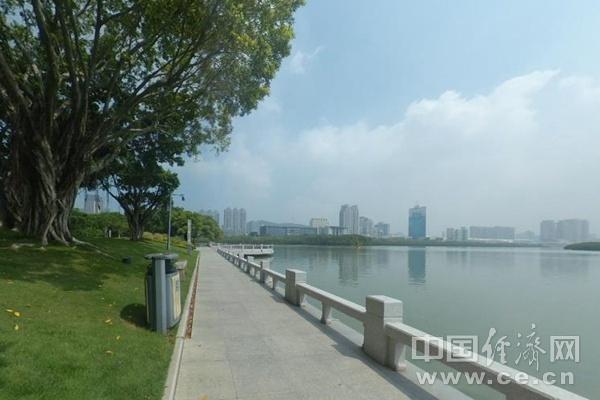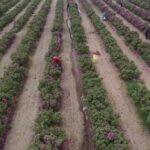The picture shows the Xiang’an Bamboo Lake in Xiamen, China.
A decade after the implementation of the ‘Ten Waters Policy,’ another major water governance document has been introduced. Recently, the ‘Beautiful Rivers and Lakes Protection and Construction Action Plan (2025-2027)’ was officially released, developed collaboratively by multiple government departments.
When we think of beautiful rivers and lakes, poetic imagery comes to mind—scenes like ‘the river flowing beyond heaven and earth, the endless hues of mountains,’ or ‘mist veiling the dreams of Cetang, waves lapping at Yueyang’s walls’… But from a development perspective, what defines a beautiful river or lake? According to the Action Plan, it aligns with the vision of ‘clear waters, lush shores, and fish leaping in gentle waves.’ Effective protection of water resources, aquatic environments, and ecosystems leads to significant improvements, enhancing public satisfaction, happiness, and safety while achieving harmonious water landscapes.
Beautiful rivers and lakes are an integral part of China’s ecological beauty. Since 2021, regions across the country have made progress, with standout examples like Shenzhen’s Maozhou River, Xiamen’s Yundang Lake, and Zhejiang’s Thousand Islands Lake among 94 exemplary cases.
The importance of constructing beautiful rivers and lakes extends beyond ecological governance—it also benefits livelihoods and well-being. For instance, Shenzhen’s Maozhou River restoration freed up 15 square kilometers of riverside space, enabling urban complexes, academic campuses, and tech hubs that attracted over 180 enterprises. Similarly, Xiamen’s Yundang Lake improved sewage treatment and flood control while creating lakeside parks and a white egret nature reserve, blending ecological beauty with practical infrastructure.
Turning ‘ecological benefits’ into ‘economic gains’—and then letting economic vitality nurture new ecological value—is a simple yet profound cycle. Ecological value conversion requires continuous innovation to remain sustainable and meaningful. Regions like Shaoxing and Jinhua in Zhejiang are exploring ways to reinvest ecological gains into further water conservation efforts, fostering public enthusiasm for environmental stewardship.
Protecting and constructing beautiful rivers and lakes demands balanced governance. Cross-regional collaboration remains a key challenge. The Action Plan promotes basin-wide coordination—upstream and downstream, left and right banks, main and tributary rivers—with a goal to safeguard cross-provincial ecological flows by 2027. It also encourages localized efforts, integrating even small water bodies into protection plans.
The Action Plan prioritizes quality and efficiency, addressing not just pollution but also ecosystem restoration. Coinciding with the International Day for Biological Diversity (May 22), this year’s theme—’From Agreement to Action: Build Back Biodiversity’—adds deeper significance. Protecting river and lake ecosystems means preserving biodiversity, which in turn safeguards humanity.
As communities enjoy ‘greenery outside their windows and scenic views at their doorsteps,’ and as more regions achieve harmony through ‘clear waters and lush shores,’ beautiful rivers and lakes will become sources of public happiness. The poetic ideal of ‘verse and distant horizons’ will transform into tangible, everyday reality.
Xiang’an Bamboo Lake
Xiang’an Bamboo Lake, located in Xiamen, Fujian Province, is a scenic area known for its tranquil bamboo forests and serene lake. Historically, the region has been valued for its natural beauty and ecological significance, with efforts made to preserve its lush landscapes. Today, it serves as a peaceful retreat for visitors and a symbol of harmony between nature and urban development.
Maozhou River
The Maozhou River is a major waterway in Shenzhen, China, historically significant for its role in agriculture and local trade. In recent decades, rapid urbanization led to severe pollution, but extensive ecological restoration projects since 2016 have revitalized the river. Today, it serves as both a functional water system and a green public space, reflecting Shenzhen’s efforts to balance development with environmental sustainability.
Yundang Lake
Yundang Lake, located in Xiamen, Fujian Province, China, is a scenic urban lagoon that was once a severely polluted harbor. In the 1980s, a major ecological restoration project transformed it into a beautiful lake with walking paths, parks, and improved water quality. Today, it serves as a model for urban environmental revitalization and a popular recreational spot.
Thousand Islands Lake
Thousand Islands Lake (Qiandao Lake) is a stunning man-made freshwater lake located in Zhejiang Province, China, formed in 1959 after the construction of the Xin’an River Dam. It is renowned for its crystal-clear waters and over 1,000 lush green islands, which were once mountain peaks before the valley was flooded. The lake also hides the submerged ruins of ancient cities, including Shi Cheng (Lion City), a well-preserved Ming and Qing dynasty relic discovered underwater in 2001.
Cetang
Cetang (also known as Tsethang or Zedang) is a historic town in Tibet, located in the Yarlung Valley near the Yarlung River. It is considered one of the cradles of Tibetan civilization and is home to several important cultural and religious sites, including the ancient Samye Monastery (the first Buddhist monastery in Tibet, founded in the 8th century). The area is closely tied to Tibetan history, mythology, and the early Tibetan kings.
Yueyang
Yueyang is a historic city in Hunan Province, China, renowned for its cultural significance and scenic beauty. It is most famous for the Yueyang Tower, a celebrated ancient pavilion built during the Tang Dynasty (618–907 AD) and later rebuilt in the Song Dynasty (960–1279 AD), known for its architectural elegance and literary connections, including a famous essay by Fan Zhongyan. The city lies near Dongting Lake, China’s second-largest freshwater lake, adding to its natural and cultural appeal.
Shaoxing
Shaoxing is a historic city in Zhejiang Province, China, renowned for its rich cultural heritage and classical water town scenery. It is famous as the hometown of influential figures like the writer Lu Xun and the calligrapher Wang Xizhi, as well as for its traditional Shaoxing wine, which dates back over 2,500 years. The city features well-preserved ancient canals, stone bridges, and traditional residences, reflecting its role as a center of literature, art, and commerce since the Spring and Autumn Period (770–476 BCE).
Jinhua
Jinhua, a historic city in Zhejiang Province, China, is known for its rich cultural heritage and scenic landscapes. It dates back over 2,200 years and is famous for its traditional *Jinhua ham*, ancient architecture like the *Eight咏 (Yong) Lane and Seven Alley* district, and the renowned *Double Dragon Cave*. The city also played a role in China’s revolutionary history and is home to prestigious academic institutions.





